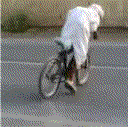The faster you're capable of going, the more margin you have when you do it slowly. A rider taking a corner at 40mph when they could take it at 60mph has less margin than a rider taking a corner at 50mph who can take it at 90mph. A rider who is calm and comfortable at 150mph will have much better concentration and ability to react to situations at 65mph than someone who starts getting a speed rush at 80mph.
So just because you can go fast, doesn't mean you have to go fast to use those skills. You'll get benefits from riding on the track whatever speed you ride on the street.
Learn to Ride Faster
Most of us, as a primary motivation, want to ride on the track to ride fast.
But what is "fast?"
"Fast" is the feeling you get when all the information you're getting from your senses -- your view of the road, the rush of the air, the engine tone, the feel at the bars, your sense of balance -- is too much for you to process. This is a bad thing -- you start overlooking things around you that are important, or the things you do see overwhelm your attention and you lose concentration. Either way, you open yourself up to serious mistakes and a bad crash.
The way to get over this "speed rush" is to practice. Riding at higher speeds around a track, where you're going around familiar corners and down familiar straights, lets you pick out the actual important cues from your senses. You start processing that information faster by learning -- mostly unconsciously -- what is and is not important. You end up filtering out all the "noise" in the input from your senses, leaving just what actually requires your attention.
When you've "trained" yourself this way -- I use quotation marks because it really is mostly an unconscious process -- you'll find that when you leave the constant repetition of the track, you'll automatically apply the same filtering to all your riding.
You probably won't notice this happening today unless you think about it. At the beginning of the day, you'll start out going relatively slowly and it will feel very fast. By the end of the day, you'll be going pretty fast, but it'll actually feel much slower because you'll have learned to handle it.
So we won't be practicing "fast." We'll be leaving the rush of "fast" behind us as we push onto a whole other level of riding.
Expand Your Tiltmeter
Each of us has a built-in mental limit to how far we can lean a bike without feeling like we're going to crash. Unfortunately this usually comes to light in avoidance situations, or when encountering a tighter curve than expected. What usually happens is the brain says "I can't lean any further" regardless of how far the bike can actually lean, and this leads to riders running off the outside of curves that the bike is fully capable of taking.
The only effective way to reset that internal tiltmeter is to ride at higher lean angles. Riding on the track, taking the same corners again and again, will lead to you doing that without even realizing it. By the end of the day you'll be leaning further and -- importantly -- more consistently than you started. The next time you hit a decreasing radius corner on the street, or a truck over the centerline in a curve, you'll be equipped to handle the situation with ease.
Recover from Mistakes
Every rider makes mistakes -- the difference between the top GP riders and the fresh out of MSF novice is that the GP guys catch them almost before they're made.
Riding on the track, by its nature as a consistent environment, helps you practice how to catch those mistakes. Learning how to pick out your own correct lines, braking points, and so on, leads to an awareness of the wrong line, the wrong braking points, and other mistakes. The more you learn how to find your own way around a track, the more you pick up on cues that you've got it wrong, and the more intuitive it is to correct those mistakes before you get yourself in trouble.
Focus
The controlled environment of a track session frees you of the need to "waste" attention on the mundane tasks of looking for errant minivans, loose gravel, horse manure, and all those other distractions you encounter on the street. That lets you focus on your technique on the actual riding. When you get back in the rough world of street riding, you'll find that since your limits have expanded, the actual riding part will take less of your attention, leaving you with more left over for avoiding those ever-present hazards.
From TrackDoD Novice Group Orientation













1 comment:
Nice topic man. Keep going!
Post a Comment